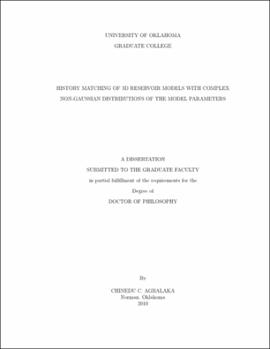| dc.contributor.advisor | Oliver, Dean S | |
| dc.creator | Agbalaka, Chinedu C. | |
| dc.date.accessioned | 2019-06-03T20:36:13Z | |
| dc.date.available | 2019-06-03T20:36:13Z | |
| dc.date.issued | 2010 | |
| dc.identifier | 9988757902042 | |
| dc.identifier.uri | https://hdl.handle.net/11244/320236 | |
| dc.description.abstract | Although the first application of the ensemble Kalman filter (EnKF) as a technique for sequential assimilation of noisy measurements was to a numerical weather prediction problem, remarkable research progress has been made in adapting this technique for application to data assimilation problems in reservoir engineering. Since its first application to a fairly simple parameter estimation problem in petroleum engineering less than a decade ago, the ensemble Kalman filter has been applied to fairly complex sequential model calibration problems in reservoir engineering with remarkable success. The reason for the rapid increase in the application of EnKF to data assimilation problems in reservoir engineering is partly due to the ease of implementing this technique; it is unnecessary to determine sensitivities from adjoint equations and the correlations between the model parameters and predicted data are estimated from the ensemble. Also the information from previously assimilated data are stored within the ensemble of conditional models such that it is unnecessary to repeat the history matching on previously assimilated data whenever new data are available for assimilation. | |
| dc.description.abstract | Despite the encouraging performance of EnKF applied to sequential model calibration problems in reservoir engineering, the formulation of the ensemble Kalman filter is based on some critical assumptions (linear forward model and Gaussian model priors) that are generally not valid for reservoir engineering problems. The EnKF performance is optimal if at each data assimilation timestep, the prior state vector is linearly related to the predicted data and the distribution of the prior state vector is multivariate Gaussian. The state vector in reservoir engineering applications consists of the static model variables and the dynamic model variables, i.e., gridblock pressures and saturations for a black oil model. Some potential issues with EnKF applied to data assimilation problems in reservoir engineering include the following: non-Gaussian dynamic and/or static model parameters in the state vector, nonlinear model--data relationship, etc. Usually, the presence of severe nonlinearities is resolved by iteration, which also resolves the problem of non-Gaussian dynamic variables. However, for history matching problems with complex non-Gaussian model parameters, such as facies variables, vertical flow barriers, multimodal model variables, etc, the nonlinear effects are exacerbated and the performance of the EnKF in adjusting the models to obtain predictions that match production data is significantly degraded. | |
| dc.description.abstract | In this dissertation, I focus on history matching problems with non-Gaussian model parameters for which the standard EnKF will perform very poorly without modifications. I identify some of the difficulties in the application of EnKF to the problem of updating facies models to match both production measurements and facies observations at the well locations and propose some modifications at the update step that improves the overall performance of the ensemble Kalman filter. I also introduce the concept of using pseudo-model variables for jointly updating the discrete facies variables and the multimodal rock properties in a way that is consistent with the EnKF updating scheme. The problem of updating reservoir models with vertical flow barriers using EnKF is also addressed in this dissertation. Estimation of vertical flow barriers is of practical importance in reservoir simulation studies as these flow barriers influence recovery mechanisms, gravity drainage processes and the selection of optimal well performance parameters. I outline three very efficient and fairly general methods for parameterizing the vertical transmissibility barriers between reservoir zones so that zonal communication can be shut off if production data indicate that there should be no communication. The EnKF will generally perform very poorly in generating conditional samples of the reservoir models if the posterior PDF is multimodal. I introduce a two-stage ensemble Kalman filter technique for application to history matching problems with multiple modes. I demonstrate the advantage of two-stage EnKF technique on a fairly complex low-order reservoir model with non-Gaussian model parameters and show that it converges to a better history match solution than the standard EnKF. | |
| dc.format.extent | 201 pages | |
| dc.format.medium | application.pdf | |
| dc.language | en_US | |
| dc.relation.requires | Adobe Acrobat Reader | |
| dc.subject | Geological modeling | |
| dc.subject | Oil reservoir engineering--Mathematical models | |
| dc.subject | Petroleum reserves--Mathematical models | |
| dc.subject | Petroleum--Fluid dynamics | |
| dc.subject | Kalman filtering | |
| dc.title | History Matching of 3D Reservoir Models with Complex Non-Gaussian Distributions of the Model Parameters | |
| dc.type | text | |
| dc.type | document | |
| dc.thesis.degree | Ph.D. | |
| ou.group | Mewbourne College of Earth and Energy::Mewbourne School of Petroleum and Geological Engineering | |
